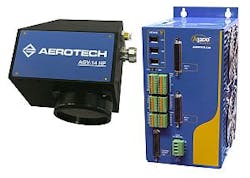The Nmark AGV-HP advanced galvanometers use optical feedback technology to increase resolution to >24 bits. Available with 10, 14, and 20 mm apertures with standard F-Theta lens interfaces, the galvanometers can accommodate 1064, 532, and 355 nm wavelengths, with other wavelengths available upon request. A variety of focal lengths are standard, with correction files provided to remove lens distortion effects. The galvanometer pairs with the Nmark CLS controller, which offers the company's Position Synchronized Output (PSO) to tie laser pulses directly to galvo position, and allows true position-based triggering.
Aerotech
Pittsburgh, PA
[email protected]
-----
PRESS RELEASE
Galvo and Controller Combination Offers Infinite Field of View and >24-Bit Resolution
Industry-best resolution of >24-bits when used with Aerotech's Nmark CLS controller
Wide range of apertures and focal lengths
Many mirror surface treatments for a variety of laser wavelengths
Nmark CLS controller has high-bandwidth linear power stage for quick settling
Position Synchronized Output for consistent laser spot placement
Infinite Field of View (IFOV) expands working area
Aerotech’s Nmark AGV-HP advanced galvanometers use innovative optical feedback technology to increase resolution to greater than 24 bits. Both the standard AGV and higher performance AGV-HP series scanners may be directly driven by Aerotech’s Nmark CLS galvo controller, which offers a full suite of advanced application tools that include Position Synchronized Output (PSO) and Infinite Field of View (IFOV). The AGV is available with 10, 14, and 20 mm apertures with standard F-Theta lens interfaces to provide maximum application flexibility. The AGV can be configured to accommodate 1064, 532, and 355 nm wavelengths, with other wavelengths available upon request. A variety of focal lengths are standard, with correction files provided to remove lens distortion effects.
Advanced Features
The ability to accurately place a laser spot as a function of X/Y axis position is a key feature of Aerotech’s linear positioning tables for laser processing applications. With the release of the Nmark CLS, this functionality is now available for scanner applications. The Nmark CLS offers Position Synchronized Output (PSO) that ties laser pulses directly to galvo position. While other scanner controllers use time-based pulses to shutter laser light, the Nmark CLS PSO allows true position-based triggering. The ability to accurately trigger the laser as a function of position removes the need to program mark, jump, and polygon delays, resulting in reduced programming complexity. By using the Position Synchronized Output functionality, scanner-based processes can now be programmed in the same fashion as traditional X/Y stage-based applications.
The Infinite Field of View feature seamlessly synchronizes servo and scanner motion under one controller environment to allow fast scanner positioning over the entire servo travel, eliminating galvo field of view constraints. The Nmark CLS has two high-power drive circuits, one for each axis in the scanner, that are optimized to get the peak performance from the AGV product family.
High-Resolution Feedback
Both the AGV and AGV-HP have thermally stable feedback transducers with virtually no gain or offset drift. The Nmark CLS uses advanced interpolation electronics to provide greater than 24-bits of effective resolution. Onboard real-time 2D calibration ensures accurate beam placement over the entire field of view.
Remote Power Devices
Most competitive scanners have the power devices integrated directly into the head, along with the galvos and feedback devices. These power devices can inject considerable thermal energy into the scanner head causing drift in the feedback positions and changing offsets between the mirrors, all of which detract from marking accuracy. Some systems use PWM power stages to minimize heat input. However, this approach results in reduced tracking accuracy due to nonlinear effects that are present when the galvo motors and control currents reverse polarity. By moving the power stage out of the head, it is possible to use higher performing transistors to drive the galvos and the heat source is effectively removed from the scanner resulting in improved system accuracy.
For further information, please contact Steve McLane at 412-967-6854 (direct), or via e-mail at [email protected].
The Nmark AGV data sheet is available at:
http://www.aerotech.com/product-catalog/galvanometers/nmark-agv.aspx
The Nmark CLS data sheet is available at:
http://www.aerotech.com/product-catalog/drives-and-drive-racks/nmark-cls.aspx
-----
Follow us on Twitter
Subscribe now to Laser Focus World magazine; it's free!
Sponsored Recommendations
Sponsored Recommendations
Request a free Micro 3D Printed sample part
April 11, 2024
How to Tune Servo Systems: The Basics
April 10, 2024
Voice your opinion!
Voice your opinion!
